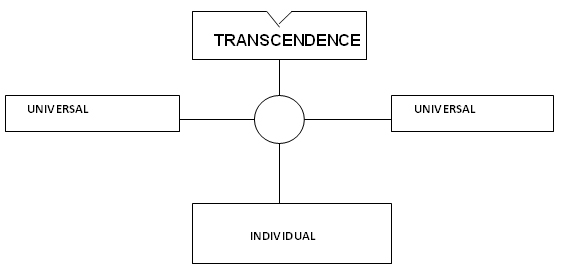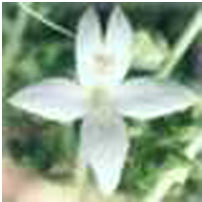|
Sri
Aurobindo asserts:
'AND STILL THERE IS A BEYOND.
For on the other side of the
cosmic consciousness there is, attainable to us, a consciousness yet
more transcendent, - transcendent not only of the ego, but of the
Cosmos itself, - against which the universe seems to stand out like
a petty picture against an immeasurable background. That supports
the universal activity, - or perhaps only tolerates it; It embraces
Life with Its vastness, - or else rejects it from its infinitude'
(The Life Divine, Pg 22)
That is the Transcendence. An
experiential contact with it leads the seer-poet to exclaim:
‘I
HAVE DRUNK THE INFINITE LIKE A GIANT’S WINE
TIME IS MY DRAMA OR MY PAGEANT DREAM’
(Sri Aurobindo Collected Poems,
Pg.133)
THE SYMBOLISATION OF THE
TRANSCENDENT
The Transcendent is symbolized by
a perfect ONENESS that potentially contains the DUALITY of both the
unity and the multiplicity, the Infinite and the Finite, the
Timelessness and the Time. THAT THE TRANSCENDENT IS SIMULTENOUSLY
ONE AND TWO (OR DUAL) AT THE SAME TIME was always known in spiritual
traditions. The Mother explains that this was the original meaning
of the Cross in Christianity.
(The Mother, Collected Works Vol. 4, pg. 393)
In
fact, The Mother who gave names to flowers in accordance with their
hidden psychological significances and symbolisms chose the
‘Cork-oak of India (Milling
tonia hortensis) to symbolize “transformation”. This flower has four
petals. The petal at the top represents the ‘transcendent’, the two
on each side represent the ‘universal’ and the one at the bottom
represents the ‘individual’.

These four petals are arranged like a cross, and The Mother points
out that as a symbol, this petal-arrangement is more perfect than
the Cross. Because the Transcendent is one and two (dual) at the
same time, the petal at the top is divided into two. What a
wonderful symbol!

Transformation (name given by the Mother to the flower of Cork-oak
of India) Cork-oak of India (Millingtonia hortensis)
Different Poises of Consciousness
In
fact, one needs to reemphasize that the Transcendent, the Universal
and the Individual are different poises of Consciousness that
COEXIST AT THE SAME TIME. The Transcendence of course is beyond the
creation and independent of creation and therefore exceeds the
‘transitory’ status of the creation which includes the cosmos and
the individual - - transitory because the solar systems can collapse
and the individual can perish while the status of the Transcendence
remains unaffected. ‘We speak as though things had unfolded in time
at a date which could be fixed: the first of January 0000, for the
beginning of the world, but it is not quite like that! There is
constantly a transcendent, constantly a universal, constantly an
individual, and the transcendent, universal and individual are
co-existent. That is, if you enter into a certain state of
consciousness, you can at any moment be in contact with the
transcendent…., and you can also, with another movement, be in
contact with the universal…, and be in contact with the
individual…., and all this simultaneously – that does not unfold
itself in time, it is we who move in time as we speak, otherwise we
cannot express ourselves.’ (The Mother, Ibid, pg. 393).
In
fact, it is the linear thinking with which we are ordinarily
accustomed that cannot conceive the simultaneity in Reality. ‘The
mind thinks about things in succession. But beyond and above,
everything exists at the same time. The One is both one and two: the
manifested and the unmanifested, everything exists at the same time.
When it is objectivised in the creation, in the manifestation, there
is a succession: one, two…But this is only a way of speaking. There
is no succession, no beginning. Beyond, in the perfect Oneness,
everything exists at the same time, simultaneously. This cannot be
understood, it must be experienced; one can have the experience of
it’.(The Mother, Collected Works, Vol. 16, pg 374-375)
'TRANSCENDENCE' AND 'GOD'
Actually, the Transcendent is called God in different religions.
Major religions in the world consider the ‘Transcendent’ to be the
only Reality making actually ‘God’ more extra cosmic than supra
cosmic. The World or the Universe as well as the Individual are
secondary or subservient to God in the Semitic traditions.
In
the Indian tradition, the supreme consciousness or God is equally
represented in the Transcendental, Universal and Individual poises.
Yet an experience of the Transcendent can suddenly give a sense of
‘unreality’ to the world. It is an overpowering experience that
influences ascetism to reject the drama of life. Thus, the creation
(comprising the universe and the individual) is considered to be
either as secondary, subservient to the Transcendence (as in the
Semitic traditions) or unreal (as in the Monist & Buddhist
traditions).
But Sri Aurobindo prefers a wider synthesis where the Transcendent,
the Universal and the Individual - all have their proper
representations. He expresses this triune status of the Divine
movingly in his sonnet, ‘The Indwelling Universal’:
The
Indwelling Universal
I
contain the wide world in my soul’s embrace:
In me Arcturus and Belphegor burn.
To whatsoever living form I turn
I see my own body with another face.
All eyes that look on me are my sole eyes;
The one heart that beats within all breasts is mine.
The world’s happiness flows through me like wine,
Its million sorrows are my agonies.
Yet all its acts are only waves that pass
Upon my surface; inly for ever still,
Unborn I sit, timeless, intangible;
All things are shadows in my tranquil glass.
My vast transcendence holds the cosmic whirl;
I am hid in it as in the sea a pearl.
(Sri Aurobindo Collected Poem,pg.142)
|

